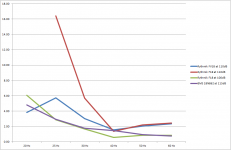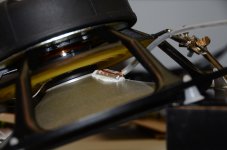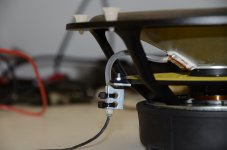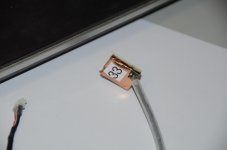Same chart, but better graphic, I hope.
I was unable to find the data you have picked out to plot at the data-bass website.
Could you please connect us with the source so we can judge for ourselves just what is being compared. That way we can determine why your chosen plots run contrary to expectation, as you already have suggested. Thanks.
B.
Last edited:
As I wrote in my post #77: "I made a simple chart with the data from Data-Bass tests". On Data-Bass site there are multiple graphs for each subwoofer, for different SPL. I took the THD data for each subwoofer, for 6 fixed frequencies at SPL=115 dB and made a chart for easy comparison. But if you want to see more details, you have to see graphs for each subwoofer and compare yourself:
Rythmik FV18: dB v2
Rythmik F18: dB v2
Velodyne DD18+: dB v2
Rythmik FV25HP: dB v2
BMS 18N862: dB v2
Rythmik FV18: dB v2
Rythmik F18: dB v2
Velodyne DD18+: dB v2
Rythmik FV25HP: dB v2
BMS 18N862: dB v2
I examined three of the systems you plotted and found your comparison, plotted for 115dB, to be seriously misleading. The Rhythmiks when played within their limitation have no distortion like you posted. If plotted at 100dB, the standings would be quite different.
Loudness discussed below is measured in an open field out of doors at a few feet. Indoors at home, that open field "100dB" might be loud enough to damage your hearing and "115dB" (when indoors) for sure.
Rhythmik FV 18 distortion is quite is low, less than 3% at 20-200 Hz (very low mid-band) up to 110dB. But louder it seems to falter although not dramatically as your plot suggests. So reporting results at 115dB as you plot is... (I'm not sure what is the best word here).
Likewise, the F 18 has almost unmeasurable distortion at 100dB, rising a bit below 30 Hz to maybe 5%.
The BMS in a larger box does produce good sound at 115dB that is not apparently to my viewing to be too much more distorted than the Rhythmiks at their lower loudness and certainly nothing like your plots would lead readers to think. But then the Rhythmics can be pushed to play 115dB although with a modest increase in distortion - but much less than other non-MFB speakers. Great driver, if very very expensive driver (plus the fancy box that data-bass had to build).
I think a fair comparison of FRs would also favour the MFB speakers.
B.
Loudness discussed below is measured in an open field out of doors at a few feet. Indoors at home, that open field "100dB" might be loud enough to damage your hearing and "115dB" (when indoors) for sure.
Rhythmik FV 18 distortion is quite is low, less than 3% at 20-200 Hz (very low mid-band) up to 110dB. But louder it seems to falter although not dramatically as your plot suggests. So reporting results at 115dB as you plot is... (I'm not sure what is the best word here).
Likewise, the F 18 has almost unmeasurable distortion at 100dB, rising a bit below 30 Hz to maybe 5%.
The BMS in a larger box does produce good sound at 115dB that is not apparently to my viewing to be too much more distorted than the Rhythmiks at their lower loudness and certainly nothing like your plots would lead readers to think. But then the Rhythmics can be pushed to play 115dB although with a modest increase in distortion - but much less than other non-MFB speakers. Great driver, if very very expensive driver (plus the fancy box that data-bass had to build).
I think a fair comparison of FRs would also favour the MFB speakers.
B.
Last edited:
I posted THD data directly taken from Data-Bass site - no misleading here. Rythmiks were played within their limitations, read carefully the tests in Data-Bass site. Rythmic FV25HP was tested also at 120 dB!I examined three of the systems you plotted and found your comparison, plotted for 115dB, to be seriously misleading. The Rhythmiks when played within their limitation have no distortion like you posted. If plotted at 100dB, the standings would be quite different.
If plotted at 100 dB, the standings will be the same! Simple logic - all subwoofers have lower THD at lower SPL. So, BMS at 100dB certainly has much, much lower THD than its own THD measured at 115dB!
According to you, how many dB you will measure indoors at home with a loudspeaker which measures 100dB outdoors?Loudness discussed below is measured in an open field out of doors at a few feet. Indoors at home, that open field "100dB" might be loud enough to damage your hearing and "115dB" (when indoors) for sure.
There is no such magic here on Earth which 100dB speaker outdoors can turn to damaging dB indoors. Read about the "Critical distance (Dc)" in any book for acoustics.
Are you aware of THX standard for surround sound, which demands subwoofer SPL = 115dB at the listening position? And Fletcher-Munson curves at low frequencies?
The best word here is: you are comparing apples and oranges! The lowest tested SPL for BMS was at 115dB, there are no measured THD data for 110dB or 100dB for BMS in the Data-Bass test. Because of that, I compared all subwoofers at 115dB (comparing apples and apples).Rhythmik FV 18 distortion is quite is low, less than 3% at 20-200 Hz (very low mid-band) up to 110dB. But louder it seems to falter although not dramatically as your plot suggests. So reporting results at 115dB as you plot is... (I'm not sure what is the best word here).
My plots do not suggests, they are obvious and hard evidence - graphs are plotted from data directly taken from measured graphics in Data-Bass tests.
Contrary to your words, Rhythmik FV18 distortion at 110dB is higher than 3% at 20, 25 and 30Hz! It is 3.87% at 20Hz, 5.72% at 25Hz and 3.03% at 30Hz. You can see these percentages also, if you position cursor from your mouse directly over the measured graph (at 110 dB) in the Data-Bass test.
Likewise, if you hover mouse cursor over the measured graph in the Data-Bass test, you will see Rythmik F18 distortion at 100dB is very measurable: 6.07% at 20Hz, 2.87% at 25Hz and 1.67% at 30Hz.Likewise, the F 18 has almost unmeasurable distortion at 100dB, rising a bit below 30 Hz to maybe 5%.
Even with such SPL discrepance, BMS at 115 dB has lower (or same) distortion than Rhythmik FV18 at 110dB and Rhythmik F18 at 110dB and 100dB - see the chart below. Or better, see the original measured graphs from Data-Bass.
The BMS box (7.6 cub. ft) is smaller than the Rythmik FV 18 box (9.2 cub. ft), but plays with lower THD at 115dB - exactly as my (i.e. Data-Bass) plots shows. The increase in distortion at 115dB from Rythmiks are not modest: 15,2% at 50Hz for FV18 and 34.2% at 20 Hz for F18 (see the plot from my post #79).The BMS in a larger box does produce good sound at 115dB that is not apparently to my viewing to be too much more distorted than the Rhythmiks at their lower loudness and certainly nothing like your plots would lead readers to think. But then the Rhythmics can be pushed to play 115dB although with a modest increase in distortion - but much less than other non-MFB speakers. Great driver, if very very expensive driver (plus the fancy box that data-bass had to build).
BMS 18N862 truly is great, but it is not "very, very expensive" - total price for the driver, amp and box is maximum $1600 - less than Rythmiks and much less than Velodyne. That "fancy box" is a bog-standard vented box.
Attachments
Last edited:
You are missing the point: the most revered Servo controlled subwoofers are much worse than an ordinary pro woofer slapped in a vented box!
"Very low cost"?? Let see:
Rythmik FV18 = $1874
Rythmik F18 = $1630
Velodyne DD18+ = $5000
Rythmik FV25HP = $2600
BMS 18N862 + amplifier Crown XLS 2502 + vented box (custom made) = $550 + $650 +$400 = $1600
"Put a servo on the BMS..."? Why on earth? BMS already has much lower distortion than the best servo controlled subwoofers in the world.
Afaik, rythmik uses a sense wire on the voice coil or the back EMF. (I forgot which one of the two it was). Neither of them are very effective as shown in the papers by RMSacoustics. Acceleration feedback based on sensor is the way to go I think, though I must admit, klippels solution looks promising.
Besides, distortion isn't the only strength of MFB. Helmoltz resonators do that fine as well. The strength is also in the transient response!
It is working - see the measurement and hear the recorded sound in the videos here:
KLIPPEL CONTROLLED SOUND
The Clippel system is not 25 years old, it is brand new. Maybe it will hit the market sooner than the expected Hypex Motional Feedback amplifier, I don't know.
Actually, he is working on this concept for a very long time. The first patents where granted in 1992! The problem is the dsp hardware, has to be very low latency and is not cheap.
The problem is more in the driver spec inconsistencies, making it time consuming to extract the non-linear ( no typo!) driver parameters on an indvidual driver to driver basis. The Universitt Twente, Hans Schurer Phd Thesis og 1998 deals with real working systems. From lab to even small scale production proved to be a no-go.
If you take random woofer in a closed box or open baffle. Measure distortion and and frequency response.
Then you add MFB and reduce the distortion and extend the linear working range, with an handfull of cheap components, and in addition to that you can with an potentiometer tweak QTS and Fs to suit you room and box size.
And the sonic result is GREAT
Give me one reason not to do it?
It seems that you are fighting the idea of motional feedback, when all of us easy can evaluate the concept and several of us has done so...
Have you not tried it your self?
Then you add MFB and reduce the distortion and extend the linear working range, with an handfull of cheap components, and in addition to that you can with an potentiometer tweak QTS and Fs to suit you room and box size.
And the sonic result is GREAT
Give me one reason not to do it?
It seems that you are fighting the idea of motional feedback, when all of us easy can evaluate the concept and several of us has done so...
Have you not tried it your self?
In theory, servo controlled subwoofers should be much better than ordinary subwoofers. But, real life is somewhat different. Data-Bass site ( dB v2 ) tested many subwoofers in great detail, including Servo controlled subwoofers. How they compare to an ordinary, plain vanilla subwoofer? I made a simple chart with the data from Data-Bass tests. Rythmik and Velodine models are well regarded Servo controled subwoofers with 18" drivers (Rythmik FV25HP has two 15" drivers). Ordinary, passive subwoofer is with 18" pro woofer BMS 18N862. All THD measurements were made at SPL=115 dB.
Here are the results (on the left side is THD percentage). Surprise, surprise!
The step you mention as "add MFB"is easier said than done. You need to have a very robust controller to overcome manufacturing tolerances.
The design of said controller is difficult and requires expertise -> expensive in labour.
Effectiveness drasticly improves when sensors are used. Mounting sensors on woofers is a labour intensive manner of production. Hence expensive.
DIY kits is not really possible because most consumers who buy the kit jsut read "MFB reduces distortion" but they don't read "not for beginners as it requires lots of knowledge about the drivers and control theory".
Klippel technique of feedback (albeit not motion feedback, it certainly is a great way of control) is very new and has not been implemented yet. There will most likely also be, not so cheap, licensing for the technology.
Don't get me wrong, I think MFB is the best way of building subs, but from a business perspective it's not always the best.
The design of said controller is difficult and requires expertise -> expensive in labour.
Effectiveness drasticly improves when sensors are used. Mounting sensors on woofers is a labour intensive manner of production. Hence expensive.
DIY kits is not really possible because most consumers who buy the kit jsut read "MFB reduces distortion" but they don't read "not for beginners as it requires lots of knowledge about the drivers and control theory".
Klippel technique of feedback (albeit not motion feedback, it certainly is a great way of control) is very new and has not been implemented yet. There will most likely also be, not so cheap, licensing for the technology.
Don't get me wrong, I think MFB is the best way of building subs, but from a business perspective it's not always the best.
Instead of taking a random woofer, why not take a very good woofers (Purify PTP6.5W04 or BMS 18N862) on the first place, without adding MFB - because they are better than any of the MFB controlled woofers? On the end, everything comes to the performance/price ratio. MFB speaker systems are anything but cheap. I would like to see and hear a low cost MFB system, of course. I am eager to see the prices of the expected new Hypex or Klippel systems.If you take random woofer in a closed box or open baffle.
I repaired, and later on, enjoyed listening several 2-way and 3-way vintage Philips MFB speakers. I am not against MFB or any other similar system for improving driver performance, but the results so far are: expensive and not better than a conventional (very) good quality woofer.
This is DIY Audio.
I did my myirst MFB subwoofer 1993 with an piezo tweeter (used as an accelerometer) glued to the voice coil and the distortion went down from 3% to 1,5% using a breadboard electronics and some 072 OP amps... At the same time f3 went from 55Hz to 18Hz.
Lots of fun, lot to learn, GREAT sound improvement and higher output.
Today i can buy a subwoofer element for 1000USD with low distortion and still reduce distortion 10dB with todays electronics from Piratelogic!
Do you see any problem if we can reduce distortion that easy?
And having fun at the same time? Sharing our experiences?
I did my myirst MFB subwoofer 1993 with an piezo tweeter (used as an accelerometer) glued to the voice coil and the distortion went down from 3% to 1,5% using a breadboard electronics and some 072 OP amps... At the same time f3 went from 55Hz to 18Hz.
Lots of fun, lot to learn, GREAT sound improvement and higher output.
Today i can buy a subwoofer element for 1000USD with low distortion and still reduce distortion 10dB with todays electronics from Piratelogic!
Do you see any problem if we can reduce distortion that easy?
And having fun at the same time? Sharing our experiences?
Instead of taking a random woofer, why not take a very good woofers (Purify PTP6.5W04 or BMS 18N862) on the first place, without adding MFB - because they are better than any of the MFB controlled woofers? On the end, everything comes to the performance/price ratio. MFB speaker systems are anything but cheap. I would like to see and hear a low cost MFB system, of course. I am eager to see the prices of the expected new Hypex or Klippel systems.
I repaired, and later on, enjoyed listening several 2-way and 3-way vintage Philips MFB speakers. I am not against MFB or any other similar system for improving driver performance, but the results so far are: expensive and not better than a conventional (very) good quality woofer.
Wow nice pics! I really like how you mounted the cable stress relief on the same spot as the voice coil terminals. Quite clever, previously it was done by hot glueing parts to the spider.
Is that a SEAS Excel W22EX? Certainly looks like the excel series at least.
This is exactly what is happening in commercial products. MFB is not a cheap solution, but it's very effective at reducing certain forms of distortion. Sometimes other solutions are more cost effective (i.e. buying a more expensive woofer).
But what if you start with a good woofer to begin with?
The purifi woofer is awesome (I am building with it myself), but it doesn't perform the same as a 10" MFB sub at 20Hz. The excursion is just too high.
MFB on the woofers doesn't work because you'll never reach the bandwidth requirement for the midrange. In fact it can even worsen the midrange performance due to the bode equality! MFB is just better suited for the sub 200Hz region and best sub 100Hz.
Purifi already mentioned, in DIY loudspeaker pad facebook page, that there are larger sizes planned (8" is in the works). I've very curious what that woofer will bring to the table.
Anyway, I've got to head back to work!
Is that a SEAS Excel W22EX? Certainly looks like the excel series at least.
Instead of taking a random woofer, why not take a very good woofers (Purify PTP6.5W04 or BMS 18N862) on the first place, without adding MFB - because they are better than any of the MFB controlled woofers?
This is exactly what is happening in commercial products. MFB is not a cheap solution, but it's very effective at reducing certain forms of distortion. Sometimes other solutions are more cost effective (i.e. buying a more expensive woofer).
But what if you start with a good woofer to begin with?
The purifi woofer is awesome (I am building with it myself), but it doesn't perform the same as a 10" MFB sub at 20Hz. The excursion is just too high.
MFB on the woofers doesn't work because you'll never reach the bandwidth requirement for the midrange. In fact it can even worsen the midrange performance due to the bode equality! MFB is just better suited for the sub 200Hz region and best sub 100Hz.
Purifi already mentioned, in DIY loudspeaker pad facebook page, that there are larger sizes planned (8" is in the works). I've very curious what that woofer will bring to the table.
Anyway, I've got to head back to work!
Nice. What is the cost of the controller electronics plus the sensor?We don't mount the sensor in the center anymore:
It looks like the wire soldered to the sensor is too thick, with too thick insulation. I would suggest much thinner tinsel wire without insulation (or with very flexible insulation) - the same used in connecting the voice coil to woofer terminals.
Edit: I didn't see your new post. But, what is the price for the whole MFB system (without the amplifier)?
Last edited:
It's the W26FX001.
And the technology is quit cheap actually: 4 murata sensors+1 opamp+2 resistors and 2 capacitors for the sensor. Control circuit consists of 2 dual opamps and a 6 dollar dsp chip.
Not when Hypex is done with it....
But then I own and use the UcD and nCore amps.
...Klippel technique of feedback (albeit not motion feedback, it certainly is a great way of control) is very new and has not been implemented yet....
Can somebody please explain the basics of how the Klippel system works. Or perhaps I should write, "Can anybody explain the Klippel system?"
The MFB aspect looks to me like back-EMF sensing using a series resistor like many years ago. Anything more in the MFB circuitry or elsewhere?
Thanks.
B.
- Home
- Loudspeakers
- Subwoofers
- Servo controlled subwoofers - why arent they used more often



